|
|
|
Matagorda Island
|
|
|
|
A True History
|
|
|
|
Hugh Walker Hawes (1798 - 1883), my great grandfather, first came to MGI from
Kentucky in 1839. He was a fairly wealthy man for his time and, by the mid
1800s, had established a lucrative receiving and forwarding business on Saluria
bayou, on the NE end of MGI, where deep draft ships could unload their cargo
without plying the shallow bay waters to their destinations.
Hawes also entered the ranching business, seeing the big advantage of the MGI
grasses and year-round grazing. When the Civil War ended, his fortune
decimated, his improvements and his home lay in ruins. He continued and
expanded his ranching operation.
|

Hugh Hawes 1798 -1883
|
He died in 1883 and is buried near his
homesite on the NE end of MGI; a large white tombstone overlooking Pass Cavallo
marks his grave. After his death the ranching operation on the island continued on by family
members until, without warning, a devastating blow was dealt to owners of all
the property on the NE 28 miles of MGI.
The US government served papers
(CA-55) and took away their lifelong heritage, and for many, their only
livelihood. This was in November 1940, a time of national emergency and the threat of
war.
|
|
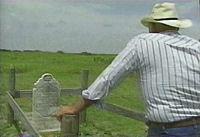
|
|
|
On February 6th, 1941, at a hearing addressing the condemnation, at the
Victoria, Texas courthouse, General Gerald C. Brant told the owners that they
would get their land back when it was no longer needed for military purposes,
the stated purpose for which taken. General Brant was spokesman for the
government, and the landowners had to believe what he said to be fact; and
binding. Interesting point- the minutes of the Feb. 6th, 1941 hearing
disappeared from the Federal Court records though we do have depositions from
some very prominent individuals who were present at the hearing. This
hearing was conducted by Maj. L. H. Hewitt, Corp. of Eng., Galveston
district.
In November 1940, some 19,000 acres on the NE end of Matagorda Island were
condemned and taken for military purposes.
|
|
|
The stated and accepted procedure for acquiring undeveloped real estate for
military usage is to negotiate with the owners and if an agreement cannot be
reached, then and only then, initiate condemnation procedures.
The MGI taking (CA-55) was just the opposite; the first the longtime owners
knew of the seizure by the government was when they were served papers by a US
marshal, and the posting of condemnation notice (CA-55) at the county
courthouse.
The owners were given ten days to remove all livestock and personal
belongings; any livestock left would be shot, they were told.
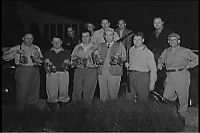 The irony of this livestock removal order was that the wealthy, politically
powerful and influential owners of the adjoining land on the SW end of MGI (the
T.L. Wynne - Clint Murchison interests), whose land was not taken, used and
grazed the condemned land all during the war an even after (1941-1947) while
displaced former owners were deprived of their livelihood and suffered both
physical and financial hardships. The irony of this livestock removal order was that the wealthy, politically
powerful and influential owners of the adjoining land on the SW end of MGI (the
T.L. Wynne - Clint Murchison interests), whose land was not taken, used and
grazed the condemned land all during the war an even after (1941-1947) while
displaced former owners were deprived of their livelihood and suffered both
physical and financial hardships.
|
|
|
The Wynne int. 11,502 acre property on the SW end of MGI adjoining the seized
land was not taken. Some two years after the A.F. Range lands were taken
the Wynne int. was afforded a limited lease, and continued full use and
enjoyment of their property.
In the late 1980s, the Wynne property was sold to the U.S. government through
The Nature Conservancy for 13.6 million dollars - nearly 1200 dollars per
acre. NOTE: Former owners of the adjoining condemned A.F. Range were paid
a court award of about seven dollars per acre, improvements and all; this, three
to four years after being put off their property.
The need for the MGI lands for military training was understandable; and the
owners took their hardships in stride. What they didn't understand was why
their property was taken in fee, instead of leased, as was all the other
training facilities in the area.i.e.
Matagorda Peninsula, just across Pass Cavallo, was taken along with Matagorda
Island (CA-55) and almost identical facilities were built and used for the same
pilot training.
The Peninsula property was returned to former owners and a lease was paid for
its use, while MGI owners suffered the loss of their property.
|
|
|
 Almost all the young Hawes men in this area were in the service in WWII; one,
Col. Edwin H. Hawes, died in combat leading an air attack on a Japanese
carrier. In 1981 another, Hugh A. Hawes, said it all when he told a
National Geographic correspondent "We went into the service. This was our
part of America. This was what we were fighting for. Now, after
forty years, we still haven't got our land back". Imagine coming home to
see the base or MGI on caretaker status,
being used for high-brass recreation, with no signs of relinquishment. Almost all the young Hawes men in this area were in the service in WWII; one,
Col. Edwin H. Hawes, died in combat leading an air attack on a Japanese
carrier. In 1981 another, Hugh A. Hawes, said it all when he told a
National Geographic correspondent "We went into the service. This was our
part of America. This was what we were fighting for. Now, after
forty years, we still haven't got our land back". Imagine coming home to
see the base or MGI on caretaker status,
being used for high-brass recreation, with no signs of relinquishment.
NOTE: Hugh did his gunnery training on MGI and was highly perturbed to see
the Wynne cattle grazing the entire Range, while his parents and displaced
owners were struggling to save some of their herd on leased land on the
mainland.
One has to ask the question "did President Franklin D. Roosevelt's visit to
the Wynne-Murchinson complex on the SW end of MGI have any bearing on the
government's taking of all 28 miles of MGI right up to the Wynne fence?"
The overpowering question on the MGI taking is and always has been; "Why
would the government condemn and take the MGI property in fee to build a
temporary training facility? -- other than the possible Wynne int. involvement;
PLUS
On the NE end of MGI near Pass Cavallo was located a Lifesaving (Coast Guard)
station built about 1879 on .29 acres of land.
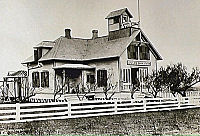 In the 1920s Air Corp officers of Brooks Field, San Antonio, Texas, began
using the Coast Guard station as guests of C.G. personnel, enjoying the
excellent hunting and fishing of MGI and, in 1929, when the station closed, the
Air Corp officer presence was expanded to include pilots of practically all A.E.
stations in Texas; calling themsleves the 'Matagorda Hunting and Fishing
Club.' The station was used as a club house and expanded usage included
vehicles, guides, etc., even though they had no land. In the 1920s Air Corp officers of Brooks Field, San Antonio, Texas, began
using the Coast Guard station as guests of C.G. personnel, enjoying the
excellent hunting and fishing of MGI and, in 1929, when the station closed, the
Air Corp officer presence was expanded to include pilots of practically all A.E.
stations in Texas; calling themsleves the 'Matagorda Hunting and Fishing
Club.' The station was used as a club house and expanded usage included
vehicles, guides, etc., even though they had no land.
This increased Air Corp recreational use of MGI continued right up to the
condemnation and taking of the MGI property. When a training base was
constructed the old Coast Guard station was burned; as was the two story ranch
house of former owners just north of the Lighthouse. Many of these
officers were generals of WWII.
Most are of the opinion that this attachment to Matagorda Island as a hunting
and fishing paradise, and the Wynne int. involvement, were the reasons this land
was taken in fee and not leased instead, and turned back to the former owners
after WWII, as was all other lands taken in this area.
|
|
|
The Surplus Property Act of 1944 was enacted to provide an orderly method of
disposal of the huge amount of property acquired by the U.S. Government to carry
out its wartime mission, when the property became surplus to its needs.
According to the Congressional Record, legislators were adamant in assuring
that taken property be returned to former owners and put back in production as
soon as practical after the war.
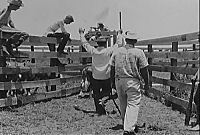 Roughly, the Surplus Property Act of 1944 gave the former owners of surplus
property priority in reacquiring their property at the taking price or the
market value, whichever the lesser. Roughly, the Surplus Property Act of 1944 gave the former owners of surplus
property priority in reacquiring their property at the taking price or the
market value, whichever the lesser.
By all evidence and fairness, the MGI property should have been surplussed,
or at least Grandfathered, under the Surplus Property Act of 1944.
The MGI range was inactivated and on caretaker status from 1945, the end of
the War, to 1949, used for recreation (hunting and fishing) for the
military.
Since the Surplus Property Act was changed in 1949, owners were never
afforded the opportunity to reacquire their land under this Act; an Act enacted
for just such cases.
In Texas the mineral estate and the surface estate are separate, and the
mineral estate is superior and dominant to the surface.
When the MGI lands were taken (CA-55) the fee simple absolute title was
taken; but, because of legal objections by owners and oil companies, plus the
value of the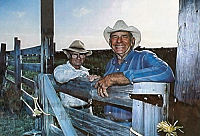 mineral estate, the government elected to revest the mineral estate
to the former owners, but found this could not be done without special
legislation, so Public Law No. 752 of the 77th Congress was enacted to permit
the taking of the surface only, and the mineral estate was revested in the
former owners. mineral estate, the government elected to revest the mineral estate
to the former owners, but found this could not be done without special
legislation, so Public Law No. 752 of the 77th Congress was enacted to permit
the taking of the surface only, and the mineral estate was revested in the
former owners.
Leaving the dominant mineral estate to the former owners further shows the
intent of Congress was to reunite these separate estates when the surface was no
longer needed or used for the purpose for which taken - namely to build a
temporary training facility for the WWII era.
|
| |
|
|
|
MatagordaIsland.com © 2006
All Rights Reserved
|
|
|